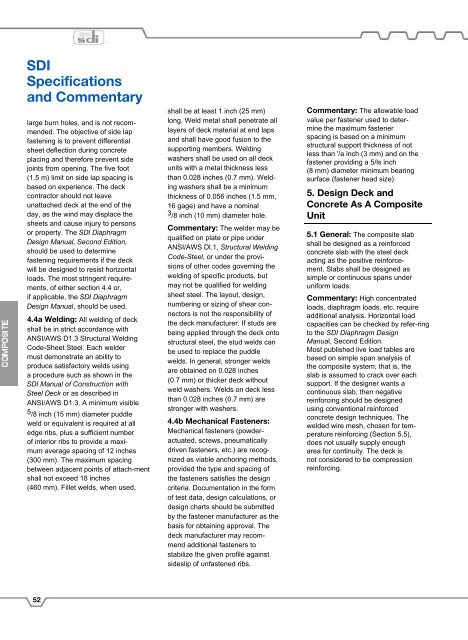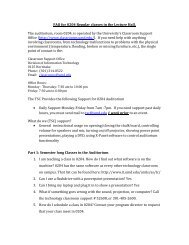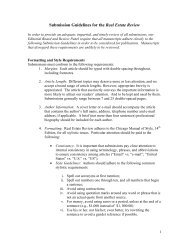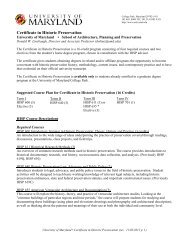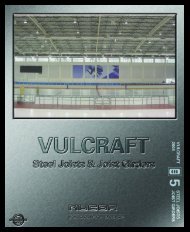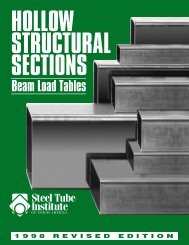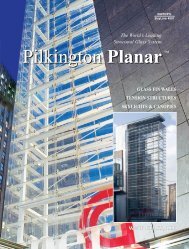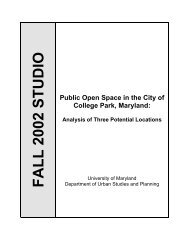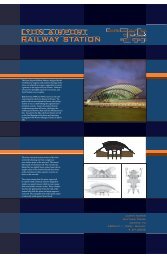Vulcraft Steel Roof and Floor Deck Catalog - University of Maryland ...
Vulcraft Steel Roof and Floor Deck Catalog - University of Maryland ...
Vulcraft Steel Roof and Floor Deck Catalog - University of Maryland ...
- No tags were found...
You also want an ePaper? Increase the reach of your titles
YUMPU automatically turns print PDFs into web optimized ePapers that Google loves.
SDI<br />
Specifications<br />
<strong>and</strong> Commentary<br />
large burn holes, <strong>and</strong> is not recommended.<br />
The objective <strong>of</strong> side lap<br />
fastening is to prevent differential<br />
sheet deflection during concrete<br />
placing <strong>and</strong> therefore prevent side<br />
joints from opening. The five foot<br />
(1.5 m) limit on side lap spacing is<br />
based on experience. The deck<br />
contractor should not leave<br />
unattached deck at the end <strong>of</strong> the<br />
day, as the wind may displace the<br />
sheets <strong>and</strong> cause injury to persons<br />
or property. The SDI Diaphragm<br />
Design Manual, Second Edition,<br />
should be used to determine<br />
fastening requirements if the deck<br />
will be designed to resist horizontal<br />
loads. The most stringent requirements,<br />
<strong>of</strong> either section 4.4 or,<br />
if applicable, the SDI Diaphragm<br />
Design Manual, should be used.<br />
4.4a Welding: All welding <strong>of</strong> deck<br />
shall be in strict accordance with<br />
ANSI/AWS D1.3 Structural Welding<br />
Code-Sheet <strong>Steel</strong>. Each welder<br />
must demonstrate an ability to<br />
produce satisfactory welds using<br />
a procedure such as shown in the<br />
SDI Manual <strong>of</strong> Construction with<br />
<strong>Steel</strong> <strong>Deck</strong> or as described in<br />
ANSI/AWS D1.3. A minimum visible<br />
5 /8 inch (15 mm) diameter puddle<br />
weld or equivalent is required at all<br />
edge ribs, plus a sufficient number<br />
<strong>of</strong> interior ribs to provide a maximum<br />
average spacing <strong>of</strong> 12 inches<br />
(300 mm). The maximum spacing<br />
between adjacent points <strong>of</strong> attach-ment<br />
shall not exceed 18 inches<br />
(460 mm). Fillet welds, when used,<br />
shall be at least 1 inch (25 mm)<br />
long. Weld metal shall penetrate all<br />
layers <strong>of</strong> deck material at end laps<br />
<strong>and</strong> shall have good fusion to the<br />
supporting members. Welding<br />
washers shall be used on all deck<br />
units with a metal thickness less<br />
than 0.028 inches (0.7 mm). Welding<br />
washers shall be a minimum<br />
thickness <strong>of</strong> 0.056 inches (1.5 mm,<br />
16 gage) <strong>and</strong> have a nominal<br />
3 /8 inch (10 mm) diameter hole.<br />
Commentary: The welder may be<br />
qualified on plate or pipe under<br />
ANSI/AWS Dl.1, Structural Welding<br />
Code-<strong>Steel</strong>, or under the provisions<br />
<strong>of</strong> other codes governing the<br />
welding <strong>of</strong> specific products, but<br />
may not be qualified for welding<br />
sheet steel. The layout, design,<br />
numbering or sizing <strong>of</strong> shear connectors<br />
is not the responsibility <strong>of</strong><br />
the deck manufacturer. If studs are<br />
being applied through the deck onto<br />
structural steel, the stud welds can<br />
be used to replace the puddle<br />
welds. In general, stronger welds<br />
are obtained on 0.028 inches<br />
(0.7 mm) or thicker deck without<br />
weld washers. Welds on deck less<br />
than 0.028 inches (0.7 mm) are<br />
stronger with washers.<br />
4.4b Mechanical Fasteners:<br />
Mechanical fasteners (powderactuated,<br />
screws, pneumatically<br />
driven fasteners, etc.) are recognized<br />
as viable anchoring methods,<br />
provided the type <strong>and</strong> spacing <strong>of</strong><br />
the fasteners satisfies the design<br />
criteria. Documentation in the form<br />
<strong>of</strong> test data, design calculations, or<br />
design charts should be submitted<br />
by the fastener manufacturer as the<br />
basis for obtaining approval. The<br />
deck manufacturer may recommend<br />
additional fasteners to<br />
stabilize the given pr<strong>of</strong>ile against<br />
sideslip <strong>of</strong> unfastened ribs.<br />
Commentary: The allowable load<br />
value per fastener used to determine<br />
the maximum fastener<br />
spacing is based on a minimum<br />
structural support thickness <strong>of</strong> not<br />
less than '/a inch (3 mm) <strong>and</strong> on the<br />
fastener providing a 5/ls inch<br />
(8 mm) diameter minimum bearing<br />
surface (fastener head size).<br />
5. Design <strong>Deck</strong> <strong>and</strong><br />
Concrete As A Composite<br />
Unit<br />
5.1 General: The composite slab<br />
shall be designed as a reinforced<br />
concrete slab with the steel deck<br />
acting as the positive reinforcement.<br />
Slabs shall be designed as<br />
simple or continuous spans under<br />
uniform loads.<br />
Commentary: High concentrated<br />
loads, diaphragm loads, etc. require<br />
additional analysis. Horizontal load<br />
capacities can be checked by refer-ring<br />
to the SDI Diaphragm Design<br />
Manual, Second Edition.<br />
Most published live load tables are<br />
based on simple span analysis <strong>of</strong><br />
the composite system; that is, the<br />
slab is assumed to crack over each<br />
support. If the designer wants a<br />
continuous slab, then negative<br />
reinforcing should be designed<br />
using conventional reinforced<br />
concrete design techniques. The<br />
welded wire mesh, chosen for temperature<br />
reinforcing (Section 5.5),<br />
does not usually supply enough<br />
area for continuity. The deck is<br />
not considered to be compression<br />
reinforcing.<br />
52


